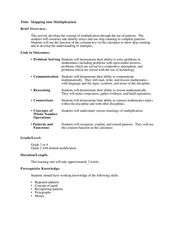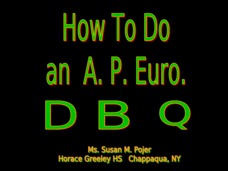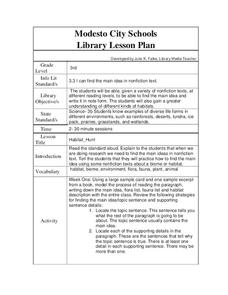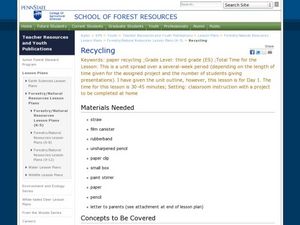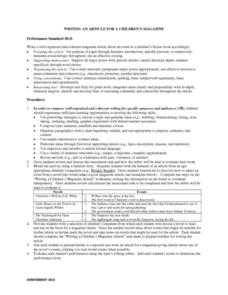Curated OER
Reading a Comparison-Contrast Essay
Turn your passive readers into active readers with an engaging lesson on reading informational text. Focused on compare and contrast structured essays, the activity prompts elementary learners to jot down questions and think-aloud...
Forest Foundation
Fire Investigation and Experimentation
Assess the probability of a wildfire with several lessons about fire danger ratings and risk factors. After experimenting with fuel moisture, learners explore the various elements that could contribute to a wildfire, such as wind...
Curated OER
Skipping Into Multiplication
Young mathematicians study the relationship between skip counting and multiplication. They build on skip counting skills and examine arrays while studying multiplication. Resources are provided.
Curated OER
Poetry Project
Choosing a poet or a theme, eighth graders conduct research in the world of poetry. They conduct Internet research and select five poems that fit their poet or theme, and create a seven slide PowerPoint presentation on their selected...
Curated OER
The Argument
After brainstorming, middle schoolers write an expository essay for a writing project. They focus on supporting points, organization, and writing conventions to develop a well-integrated paper. In addition, they revise, proofread and...
Curated OER
High School Literary Paragraph Development
You can cover literary elements, writing organization, and proofreading skills in this SMART board instructional activity. Using student paragraphs from a previous assignment, the class reviews the best examples of writing. A SMART board...
Virginia Department of Education
Arithmetic and Geometric Sequences
Future mathematicians learn about arithmetic and geometric sequences, as well as common ratios and differences as they complete a worksheet matching sequences with the algebraic expressions that represent them.
Florida Center for Reading Research
Vocabulary: Word Analysis, Meaning Map
Lead young learners to understand new vocabulary with this series of word maps. The first of these organizers asks children to determine the definition and provide examples and descriptions of each word with the help of dictionaries,...
Curated OER
How To Do an AP Euro DBQ
Are your AP classes struggling with Document Based Questions? Nip their problems in the bud with this clear and comprehensive presentation, which compares a "dazzling DBQ" to a hamburger, outlining all of the layers therein....
Curated OER
Parts of Speech
Nouns, verbs, pronouns...they're all covered here! This presentation gives a detailed look at each part of speech, but know that you cannott skip slides or start at any slide except for the first. Create a guide to keep your class...
Oakland Unified School District
Class Animal Report
Whether preparing your second graders for an expository writing proficiency assessment or just planning on introducing the writing process, this 37-page packet is for you. The unit has everything you need from scripted lessons to...
Curated OER
Figurative and literal language through the study of Shakespeare
Sixth graders explore figurative and literal language. They study literary devices through short pieces of Shakespeare's work. Then investigate Shakespeare's works and life.
Curated OER
Habitat Hunt
Third graders read several nonfiction texts and practice finding the main idea for the text as well as learn about various habitats. In this main idea lesson, 3rd graders read several nonfiction texts and make habitat cards. Students...
Curated OER
Summarizing
Students summarize articles, editorials, and news programs. In this writing skills lesson, students take notes on news stories about one issue from more than one source and then write summaries of the issue using rule-based summary...
Curated OER
Recycling: Creative Uses for Items
Third graders list creative uses for old objects. In this recycling lesson, 3rd graders work in groups to brainstorm creative, new uses for old, everyday items. This is the first lesson in a unit on recycling.
Curated OER
PICTURE READING - PARAGRAPH WRITING
Students investigate the elements found in a media image. The image is used to compose a descriptive paragraph. They exchange papers to discuss the writing and make changes using constructive criticism. Students also make connections...
Curated OER
Writing a Letter of Inquiry!
Students examine and discuss brevity of business letters, create focused and catchy letters, and publish a typed letter that is suitable for mailing.
Curated OER
WRITING AN ARTICLE FOR A CHILDREN'S MAGAZINE
Students engage in the writing of a magazine article. They focus upon the reading of a children's fiction book and create an informative narrative. They create main ideas and supporting details for the article. The supporting of main...
Curated OER
Creating a Digital Newspaper
Learners create a digital newspaper. In this digital newspaper instructional activity, students review the sections of a newspaper and brainstorm ideas for their paper. Learners complete a schools news report, student interview, opinion...
Curated OER
How the West Was One: A Layered Book
Students create a layered book about the information they learn about the Western region of the United States. In this Western states lesson plan, students create a book about the land, economy, and culture.
Curated OER
Maize to Maquiladoras: Movement from Mexico to Arizona
Fourth graders label maps of Arizona and Mexico to show the people, goods, and ideas that have moved between the two places. In this Arizona and Mexico lesson plan, 4th graders summarize the effects of the movement on Arizona life.
Curated OER
Earthquake!
Students gain an understanding of earthquakes. They examine vocabulary associated with earthquakes, how earthquakes happen, and preventive measures taken to diminish damage or harm in the event that an earthquake should happen.
Curated OER
Ethos, Logos, and Pathos
Learners compare and contrast "Letter From a Birmingham Jail" and "Civil Disobedience" by writing a paper using MLA format.
Curated OER
Writing Original Directions
Third graders create original design directions. Each student creates a design and composes directions for re-creating it. Then, when students form pairs, they take turns drawing from one another's written directions.


